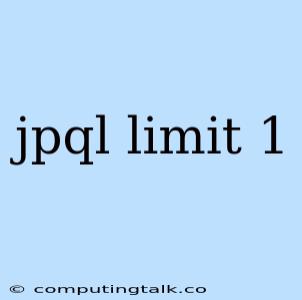JPQL Limit 1: A Deep Dive into Efficient Data Retrieval
JPQL (Java Persistence Query Language) is a powerful tool for querying data in Java applications using JPA (Java Persistence API). When working with JPQL, you often need to retrieve specific data sets. One common scenario is to retrieve only the first record matching your query criteria. This is where the LIMIT 1 clause comes into play, providing a highly efficient way to achieve this goal.
Understanding the Power of LIMIT 1
The LIMIT 1 clause acts as a data filtering mechanism within your JPQL query. It instructs the persistence provider to return only the first entity that satisfies your query's conditions.
Why is this important?
- Efficiency: Instead of fetching the entire result set and then processing it to extract the first element, LIMIT 1 directly targets the first matching entity, significantly optimizing query execution.
- Resource Optimization: By limiting the result set to one record, you reduce the amount of data transferred between the database and your application, further enhancing performance.
- Targeted Retrieval: When your application only requires the first matching entity, LIMIT 1 provides a precise and streamlined approach to data retrieval.
JPQL Limit 1 in Action
Let's look at a practical example to illustrate the usage of LIMIT 1. Consider a scenario where you have a table named Customer with columns like id, name, and email.
Scenario: Find the first customer whose name starts with "John".
Query query = entityManager.createQuery("SELECT c FROM Customer c WHERE c.name LIKE 'John%' ORDER BY c.id ASC LIMIT 1");
Customer firstCustomer = (Customer) query.getSingleResult();
Explanation:
SELECT c FROM Customer c: This part of the JPQL query specifies the entity (Customer) and its alias (c) to be retrieved.WHERE c.name LIKE 'John%': TheWHEREclause filters the results to include customers whosenamestarts with "John".ORDER BY c.id ASC: This clause ensures that the results are ordered by theidcolumn in ascending order. This is particularly important when you need to guarantee the retrieval of a specific first record in a dataset that is not inherently sorted.LIMIT 1: The core of the optimization. This clause instructs the persistence provider to return only the first matching entity.
Important Considerations
While LIMIT 1 is a powerful tool, it's important to note a few considerations:
- Ordering: If you don't explicitly specify an
ORDER BYclause, the order in which the results are returned might be unpredictable. WithoutORDER BY, the "first" record might not always be the same. - Unique Constraints: If your query is likely to return multiple records, you can consider adding a
DISTINCTclause to ensure you only retrieve one unique entity, even without theLIMIT 1clause. - Database Specific Limits: Some databases might have limitations on the maximum number of results allowed by the
LIMITclause.
Beyond the Basics
The LIMIT 1 clause is a fundamental part of JPQL query optimization. It enables efficient data retrieval, reducing the amount of data processed and improving application performance. Remember to use it judiciously, ensuring you have appropriate ordering and considering database specific limitations.
Conclusion
The LIMIT 1 clause within JPQL empowers you to retrieve only the first matching entity, resulting in significant performance gains. By limiting the data transferred and focusing on the desired record, you enhance application efficiency and resource utilization. Understanding the strengths and limitations of LIMIT 1 is crucial for building optimized and robust Java applications that efficiently access data from your persistent layer.
